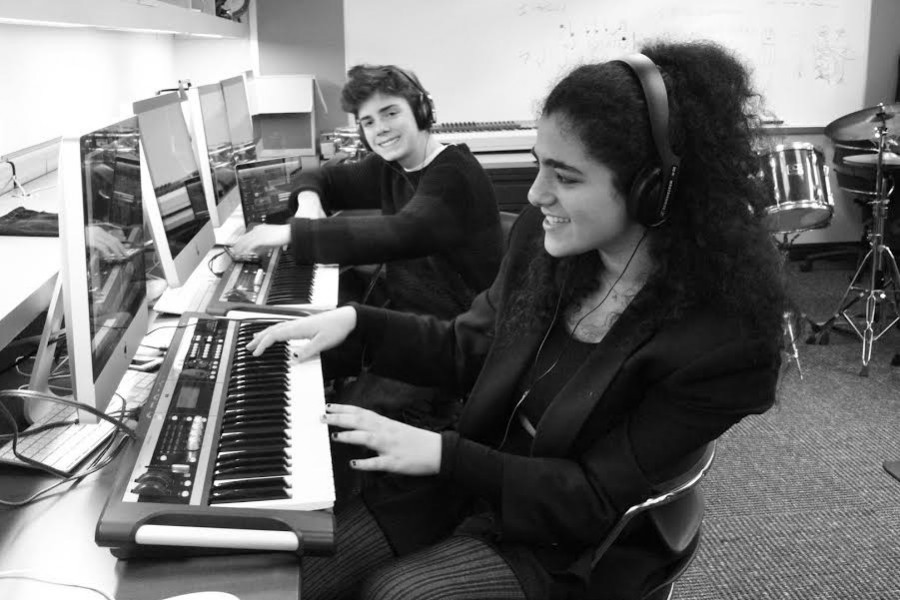Behind the Music
The Students of the Composition Class
Photo credit: Katrina Holceker
Eddie Burns (left) and Natasha Lerner (right) create music during their class.
Music Composition is not a new class offered at Parker, but it is one of the smallest–senior Eddie Burns and junior Natasha Lerner, who gave a 15 minute presentation about their class in Morning Ex on October 21, are the only members.
According to Middle and Upper School music teacher Alec Synakowski, the course offers students the opportunity to “engage in music at the highest level.” The course aims to build students’ music composition and editing skills, Synakowski added, as well as familiarize them with Garageband and Logic, two music development softwares.
The class, created by former music teacher Lucius Bell and current music department chair Sunnie Hikawa in the mid 1990’s after they received a keyboard synthesizer from the senior class, has been offered every year since. Class sizes have been fairly small. Bell and Hikawa hoped to increase their students’ abilities to create music and to give them skills that they could use in other aspects of their life.
Music Composition meets four times a week in the small Musical Instrument Digital Interface (MIDI) lab tucked beside the middle school hallway. The class agenda changes daily based on current assignments.
In an average class, Burns and Lerner review and reflect on previous projects. Then they write down their thoughts about the process of composing a current song and brainstorm potential improvements. After they reflect, Lerner and Burns finish and share their new projects with Synakowski and each other.
A recent task, assigned on October 26, was to create a song in 24 hours. They were challenged to speed up their songwriting process while maintaining a high quality of work. The hardest part, according to Lerner, was not the writing itself but being satisfied with the end results. “I had less time to change my song and lyrics,” she said, “so I just had to be okay with the song in a short amount of time.”
Both agree that the songwriting process involves a lot of trial and error. Some of Lerner’s approaches involve tinkering with chords and repetition.
“I find and play chords that I like, and then I play them over and over again,” Lerner said. “There’s a melody that forms in my head, and I hum that, and I come up with words. Then I sing the words with the chords, and if they don’t sound good, I’ll switch the words.”
After finishing a song, Burns finds it hard to let his final project be. “Being satisfied and finishing a song is so much harder that starting a song,” Burns said. “You don’t know if you should keep adding stuff, or let it be.”
Throughout this process, Synakowski offers guidance and feedback. Small but key additions to the students’ songs are often the product of Synakowski’s input. Sometimes suggestions are to add background sounds, like snaps or bass chords, that will enhance the song. Finishing touches from the students require experience and restraint so as not to overwhelm the song.
Garageband and Logic each offer a huge library of instruments and sounds, so students can select and layer as many instruments as they please. Students simply choose which software they like better.
Composing music on computers allows for easy edits and additions. Changing tone, key, and timing are easy to do and essential to improving new compositions. Both Lerner and Burns agree that the softwares are useful tools.
When the class was first created, a keyboard synthesizer was all the students had to work with, but as technology has advanced, so have music softwares and electronic instruments. By the end of the semester, Lerner hopes to have improved her music writing and composing skills, among other things.
“I hope to get better at putting songs together,” Lerner said. “I like writing them and then adding more to them besides the singing and the piano chords that I initially write.”
Each assignment is different from the last in order to broaden the students’ skill sets and to increase their flexibility, according to Synakowski. Burns and Lerner’s next assignment, as of this reporting, was to create background music for an iPhone 4S advertisement. They were to spend the next week composing, editing, and finalizing their song–and then present it to Synakowski and the other member of the class.
One of the hardest aspects of creating music can be sharing it with peers or the public. Burns, for his part, isn’t fazed by sharing his work. “I’m fearless,” he said.







